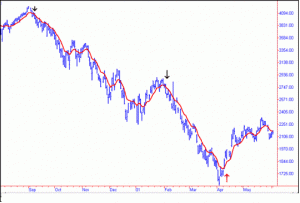A weighted average is any average that has multiplying factors to give different weights to different data points. Mathematically, the moving average is the convolution of the data points with a moving average function; in technical analysis, a weighted moving average (WMA) has the specific meaning of weights which decrease arithmetically
A weighted moving average is also designed to put more weight on recent data and less weight on past data. A weighted moving average is calculated by multiplying each of the previous day’s data by a weight. The following table shows how a 5-day weighted moving average is calculated.
The Weighted Moving Average WMA is measured by averaging all the previous values over the given period, (also the ongoing value). These values are weighted linearly (the oldest value gets a weight of 1, the next value gets a weight of 2, and so on up to the ongoing value, which gets the same weight as the period).
Note how the 5-day weighted moving average gives five times more weight to today’s price (i.e., 5 * 29) than to the price five days ago (i.e., 1* 25).
Moving averages can be used to see trends, that’s why they can also be used to predict if data is bucking the trend. A weighted moving average is measured by multiplying each of the previous day’s data by a weight. The weight in its turn is based on the number of days in the moving average. In this example, the first day’s weight is 1.0 while the value on the most recent day is 5.0. This gives 5 times more weight to today’s price than the price 5 days before.
